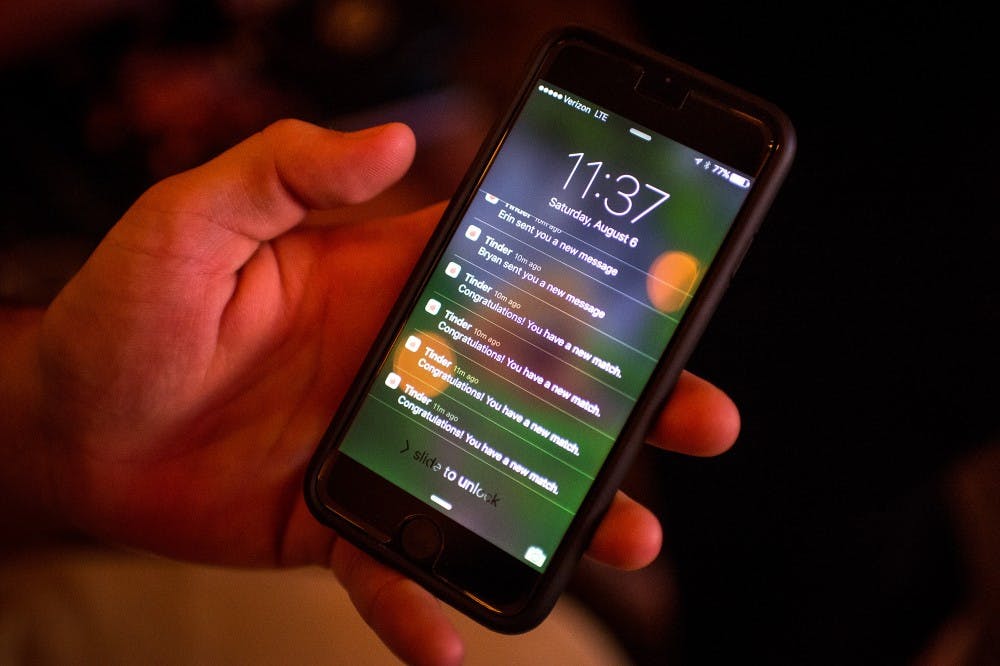Online dating is a fact of life for many young people, but the science behind right swipes isn’t so obvious.
Weekend spoke to two Kinsey Institute for Research in Sex, Gender and Reproduction experts about the long history of dating service stigma, their tips for successful profiles and the future of dating apps.
Justin Garcia of the Kinsey Institute works as a scientific adviser for match.com’s annual Singles in America study.
App usage is not the study’s focus, but sister sites like OkCupid and Tinder are included in the match.com roundup, Garcia said.
In many parts of the world, relatives are very involved in the dating search and even arrange marriages for younger singles. The social networking aspects of many dating services mimics that involvement, Garcia said.
“There are patterns that have been part of human society for hundreds of years, and that’s using social networks to vet partners,” he said. “What the websites, I think, do is carry on a very ancient tradition of helping people find partners.”
In the seven years since the SIA study began, the internet has surpassed every other method of finding dates, from setups through friends to casual meetings at bars or church, Garcia said.
In its 2017 release, SIA found that 40 percent of “actively courting singles” met their most recent first date through an app like Tinder or Bumble, while only 24 percent met through friends. Fewer than six percent had met their dates at bars.
Amanda Gesselman works with the same SIA data in the Kinsey Institute and focuses on technology use and how it influences relationships.
She said while established websites like match.com and eHarmony don’t carry much of a stigma anymore, apps — especially ones that are associated with hook-ups instead of romance — still do.
However, Gesselman said she thinks stigma against dating services was present before the internet became involved in dating.
“Being a single adult is something that’s been stigmatized forever, probably,” she said. “It’s been something that’s perceived as different or abnormal.”
People who were set up by relatives in decades past have been stigmatized in their search for a partner, Gesselman said, as were those who posted classified ads.
“I can just say that as things become more normal, stigma declines,” she said.
Although there are many ways to use online dating services, some general rules of thumb apply to most modern sites and apps.
Garcia said one of the best ways to connect is to include a question in messages to potential partners.
“A good way to think about it is like natural speech, and in natural speech, you often ask a question to engage,” he said. “It also shows you’re interested in the person, that you’ve read the profile and looked at the pictures.”
Garcia also said messages to potential partners should be brief.
“Keep it short,” he said. “Keep it under five sentences. Don’t send paragraphs. That’s good, data-driven advice.”
Gesselman is studying emoji use in profiles and messages, the use of which is positively correlated with going on more dates and having more sex.
Emojis are a tech-savvy way to communicate with potential partners that work as a social proxy for the facial and verbal cues users would normally get from a face-to-face conversation, she said.
“People who use emojis more often have a higher level of emotional intelligence, and they’re also more likely to be social and agreeable,” Gesselman said.
Because humor, intelligence and individuality are all helpful qualities to convey in a profile, Gesselman suggested users add emojis that “convey your warmth, your ability to laugh at yourself — some part of your personality that would attract the kind of person you’re looking for.”
The next step in online dating could help singles determine whether they’ll be compatible with another person before they go on the first date.
Garcia thinks website and app manufacturers could add video and audio clips to user profiles for added realism.
It’s difficult to determine whether text or chat conversations will translate into chemistry in real life, but providing more physical data on the other person could help.
“You’d maybe hear the sound of their voice or see them moving,” he said. “I think that’s where dating sites are going to go to really magnify the experience.”
Gesselman said there are many problems with online dating that could be solved, but would require a larger societal shift.
Most of the frustration she hears of stems from users not knowing what a potential match wants from the dating experience or if their goals align.
Tinder’s most recent statistics report about 1.4 billion swipes per day, although only about 26 million ended in matches — less than two percent.
Some Tinder users will swipe looking for casual encounters, while others want a long-term, committed relationship.
Others swipe in search of texting conversations, but have little interest in meeting in person.
“I don’t know that there’s a good way to solve that,” Gesselman said. “Until we are a more or fully sex-positive culture, people will be hesitant to say that they’re looking for sex rather than a relationship.”




